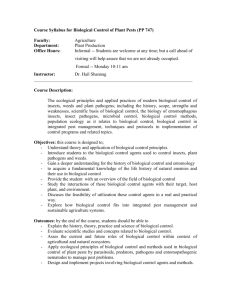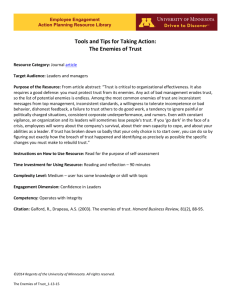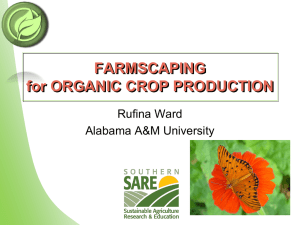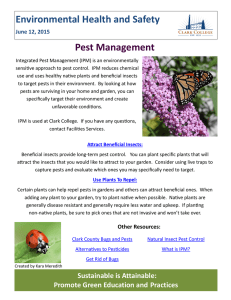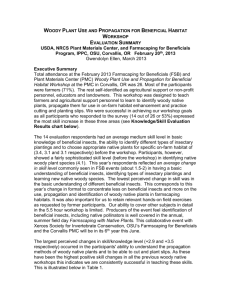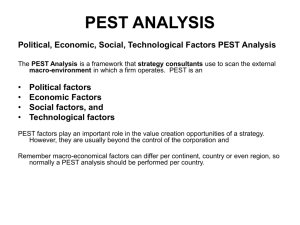Improving Pest Management with Farmscaping
advertisement
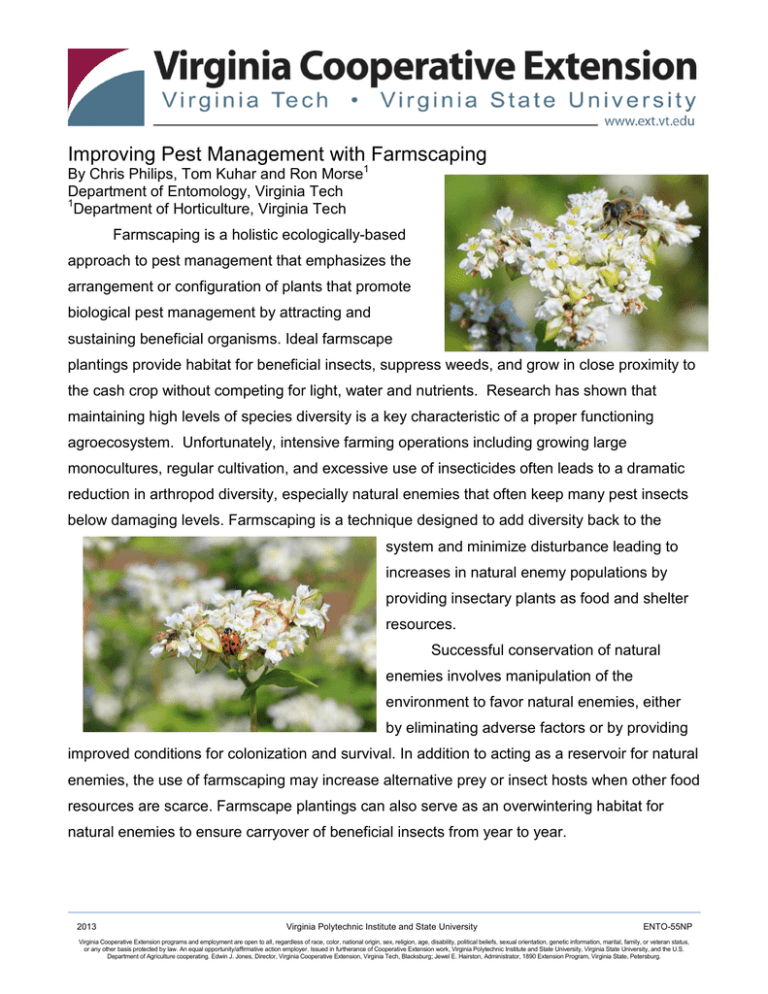
Improving Pest Management with Farmscaping By Chris Philips, Tom Kuhar and Ron Morse1 Department of Entomology, Virginia Tech 1 Department of Horticulture, Virginia Tech Farmscaping is a holistic ecologically-based approach to pest management that emphasizes the arrangement or configuration of plants that promote biological pest management by attracting and sustaining beneficial organisms. Ideal farmscape plantings provide habitat for beneficial insects, suppress weeds, and grow in close proximity to the cash crop without competing for light, water and nutrients. Research has shown that maintaining high levels of species diversity is a key characteristic of a proper functioning agroecosystem. Unfortunately, intensive farming operations including growing large monocultures, regular cultivation, and excessive use of insecticides often leads to a dramatic reduction in arthropod diversity, especially natural enemies that often keep many pest insects below damaging levels. Farmscaping is a technique designed to add diversity back to the system and minimize disturbance leading to increases in natural enemy populations by providing insectary plants as food and shelter resources. Successful conservation of natural enemies involves manipulation of the environment to favor natural enemies, either by eliminating adverse factors or by providing improved conditions for colonization and survival. In addition to acting as a reservoir for natural enemies, the use of farmscaping may increase alternative prey or insect hosts when other food resources are scarce. Farmscape plantings can also serve as an overwintering habitat for natural enemies to ensure carryover of beneficial insects from year to year. 2013 Virginia Polytechnic Institute and State University ENTO-55NP Virginia Cooperative Extension programs and employment are open to all, regardless of race, color, national origin, sex, religion, age, disability, political beliefs, sexual orientation, genetic information, marital, family, or veteran status, or any other basis protected by law. An equal opportunity/affirmative action employer. Issued in furtherance of Cooperative Extension work, Virginia Polytechnic Institute and State University, Virginia State University, and the U.S. Department of Agriculture cooperating. Edwin J. Jones, Director, Virginia Cooperative Extension, Virginia Tech, Blacksburg; Jewel E. Hairston, Administrator, 1890 Extension Program, Virginia State, Petersburg. Ideal plants for farmscaping If the goal of farmscaping is to increase the numbers and health of natural enemies as well as to maintain them o your farm, then it is important to make the resources required by beneficial insects readily available whenever they are needed. Examples include plants with flowers that provide ample nectar and pollen production, plants that sustain beneficial insect populations until they are needed, and plants with flowers with rewards accessible to natural enemies, but not pests. Choosing appropriate plants can be based on plant characteristics including floral attraction, nectar accessibility and nutritional suitability allowing for the identification of plants that meet the needs of beneficial insects, while at the same time reduce the risk of pest outbreaks. Most beneficial insects feed on nectar and pollen at some point in their life, so these two characteristics are essential considerations in farmscaping. Studies have found that floral area, peak bloom, flower height, and decreasing corolla width are the most important characteristics in attracting natural enemies; however, they are also the most important in attracting herbivores as well. Many plants in the carrot family (Apiaceae) make exceptional famscaping plants because they contain exposed floral nectaries. In addition, many plants in the legume family (Fabaceae) contain extra floral nectaries, which are nectar glands not associated with the flower, make resources highly accessible. Different plant families provide these resources in different ways, and some, such as buckwheat, have become staples in farmscapes. It is important when thinking about farmscaping to try to choose plants that will provide multiple benefits, such as increasing soil fertility, providing beneficial resources, and suppressing weeds. Buckwheat. Although numerous plant species can serve as pollen and nectar sources for natural enemies, buckwheat (Fagopyrum esculentum) has been touted as an ideal farmscaping plant, because it provides abundant, easily accessible nectar, has extra-floral nectaries, a long bloom time, suppresses weed growth, is inexpensive, and is easy to manage. In addition, no major crops are closely related to buckwheat and thus it should not attract or harbor additional pests. Buckwheat has been widely used as a companion planting in agriculture to supply nectar and pollen and encourage arthropod natural enemy populations. Nevertheless, because little is known about the nectar availability requirements for specific natural enemies it is a good idea to plant a mix of flowering plants from various plant families to ensure that resources are available to the target beneficials at the right time. This is the idea behind the commercially-available multiple plant species seed mixes that work well in attacking a wide range of beneficial insects. Numerous organic gardening periodicals have published comprehensive lists of plants recommended for farmscaping such as Rodale's Successful Organic GardeningTM Companion Planting, Rodale Press, 1994. We listed some of the most popular companion plants in Table 1. Why should I farmscape? While the primary goal of farmscaping is to improve pest management it is important to remember that farmscaping plants can add value beyond biological control, such and cut flowers and medicinal plants also have multiple uses. Additional reasons include: 1. Work smarter, not harder. Working with and using natural processes, like farmscaping, will help control pests sustainably, increasing farm productivity with less direct intervention thus minimizing labor inputs. 2. Increased profits. Farmscaping lowers the production costs of crops by encouraging and using natural enemies to suppress pests below threshold. 3. It’s cheap and easy! You only need to farmscape about 5% of field area. Thus, for every acre, you need about 2200 square feet of flowering plants which costs between $5.00 - 10.00. 4. You can put farmscaping plants anywhere. As long as the plants are near your cash crops, you can utilize otherwise unusable land such as drainage ditches and steep banks. 5. Erosion control/soil building. Farmscaping in places that are easily eroded gives stability to the soil and can be used as buffers, providing benefits to crops growing nearby. References Altieri, M. A., and D. K. Letourneau. 1982. Vegetation management and biological control in agroecosystems. Crop Protection. 1: 405-430. Dufour, R. Farmscaping to enhance biological control: Pest management systems guide [Online]. NCAT. ATTRANational Sustainable Agriculture Information Service. Available at:http://attra.org/ Gurr, M. S.D. Wratten and M.A.Altieri (eds.) 2004. Ecological engineering for pest management: Advances in Habitat Manipulation for Arthropods CABI Publishing, Ithaca, NY. Gurr, G. M., S. D. Wratten, W. E. Snyder, and D.M.Y. Read. 2012. Biodiversity and Insect Pests, Key Issues for Sustainable Management. John Wiley & Sons Chichester, UK. Winkler, K., F. L. Wäckers, A. J. Termorshuizen, and J. C. van Lenteren. 2010. Assessing risks and benefits of floral supplements in conservation biological control. BioControl. 55: 719-727. Zehnder et al. 2007. Arthropod pest management in organic crops. Annual Review of Entomology. 52: 57-80. Table 1. Some flowering plants known to attract arthropod natural enemies. Carrot Family (Apiaceae) Pimpinella anisum Anise Trachymene caerulea Blue Lace Carum caryi Caraway Anthrisdcuss cerefolium Chervil Coriander/Cilantro Coriandrum sativum Anethum graveolens Dill Foeniculum vulgare Fennel Lovisticum officinale Lovage Ammi majus Bishops Lace Daucus carota Wild Carrot Aster Family (Asteraceae) Liatrus pycnostachya Blazing Star Anthemis nobilis Chamomile Cosmos binpinnatus Cosmos Echinacea spp. Coneflower Coreopsis spp. oreopsis Golden Marguerite Anthemis tinctoria Solidago altissima Goldenrod Tagetes tenuifolia Marigold, Signet Mexican Sunflower Tithonia tagetifolia Helianthus spp. Sunflower Tanecetum vulgare Tansy Achillea millefolium Yarrow, milfoil Macrophylla taygetea Yarrows Legumes (Fabaceae) Medicago sativa Alfalfa Vicia grandiflora Big flower vetch Vicia fava Fava bean Vicia villosa Hairy vetch Melilotus officinalis Sweet clover Trifolium pratense Red clover Trifolium repens White clover Cabbage Family (Brassicaceae) Barbarea vulgaris Yellow rocket Lobularia maritime Sweet Alyssum Iberis umbellate Candytuft Brassica spp. Mustards Teasel Family (Dipsaceae) Cephalaria giganitica Cephalaria Dipsacus spp. Dipsacus Scabiosa caucasisca Pincushion Flower Scabiosa atropurpurea Scabiosa Mint Family (Lamiaceae) Mentha piperata Peppermint Mentha spicata Spearmint Thymus spp. Thyme Other Species Fagopyrun esculentum Buckwheat Potentilla spp. Cinquefoil
